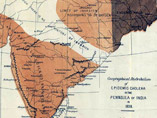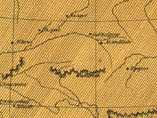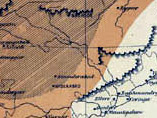 About the collection
About the collection
The Medical History of British India collection consists of official publications varying from short reports to multi-volume histories related to disease, public health and medical research between circa 1850 to 1920.
Important developments
These publications are historical sources for a period which witnessed the transition from a humoral to a biochemical tradition, which was based on laboratorial science and document the important breakthroughs in bacteriology, parasitology and the developments of vaccines in a colonial context. The collection at the National Library of Scotland includes:
- Reports of commissions and committees appointed to investigate diseases and preventive measures undertaken by the state.
- Regulations for colonial officials outlining measures to prevent the spread of specific diseases.
- Scientific accounts of laboratorial research investigating the nature of a disease and its mode of transmission to human beings (these also contain accounts of pioneering research on 'tropical diseases' like Leishmaniasis or kala azar).
- Regional surveys reporting the extent and prevalence of diseases through statistical and descriptive accounts, including detailed maps.
- Reports of outbreak of epidemic disease in specific places (for instance, the account of the outbreak of cholera in village Akhoree, North-Western Provinces).
- Documents prepared for the education of lower level medical staff regarding diseases and their prevention.
- Government Resolutions on specific diseases and public health.
- Reports of the workings of the Lock Hospital system following the Indian Contagious Diseases Acts of 1864 and 1868.
- Regional reports on the medical and sanitary conditions of army personnel.
- Annual reports from medical schools and research institutions.
Regional histories of disease
These documents form invaluable source material for the reconstruction of the history of disease and medicine in British India. Although a large section of it has an all-India scope, the collection is especially rich in documents related to Bombay and the Punjab. The Bombay plague of 1896-1899, one of the severest outbreaks, is particularly well covered.
Many of the documents focus on epidemics in specific presidencies with vivid detail that makes them treasure-trove of regional histories of disease – the narrative discusses the affect of diseases on the social fabric of small villages and towns in detail and the account is illustrated with detailed topographical maps. The extensive statistics accompanying these documents provide important data that would be valuable for regional histories.
Advances in treatment
These historical sources reveal the development of surveillance systems and the official response to epidemic emergencies within a colonial context, providing vital insights into the role of government and the operation of colonial power. Many of the breakthroughs and advances in the treatment and prevention of communicable diseases are represented in the collection, and a number of the titles are either about or by prominent figures in the field (for example, Sir Ronald Ross and W M Haffkine, S R Christophers).
They should therefore be of great interest to medical, social, military and colonial historians, historians of South Asia and also genealogists. This material traces the epidemiology and etiology of communicable diseases that cause a high mortality in the Third World even today. Epidemiologists, medical practitioners and researchers in this field should find them valuable.
Maps showing the geographical distribution of epidemic cholera between 1859 and 1869
Map showing geographical distribution of epidemic cholera in 1859 »
Map showing geographical distribution of epidemic cholera in 1860 »
Map showing geographical distribution of epidemic cholera in 1864 »
Map showing geographical distribution of epidemic cholera in 1865 »
Map showing geographical distribution of epidemic cholera in 1869 »








